
It’s no secret that a social media calendar is an indispensable tool for individuals and organizations aiming to maximize their online presence.
It serves as a strategic planner for your social media content, ensuring that your posts are timely, relevant, and aligned with your overall marketing objectives.
This article gives you a step-by-step guide to creating an effective social media content calendar, including the use of templates and apps.
What is a social media calendar?
A social media calendar is a schedule of when and where you plan to publish upcoming content across your social media platforms.
It includes details such as the date and time of posting, the platform used, and the content’s format (e.g., text, images, videos).
This organizational tool can range from a simple spreadsheet to a more complex software application designed specifically for content planning and social media management.
The use of a social media content calendar goes beyond mere scheduling; it allows for the strategic planning of your content in alignment with your social media marketing goals.
It helps ensure that your content is distributed evenly across platforms and time, avoiding the pitfalls of content gaps or overwhelming your audience with too much content at once.
Benefits of using a social media calendar
Implementing a social media calendar comes with numerous advantages:
- Consistency and Cohesion: A calendar helps maintain a consistent posting schedule, which is crucial for building and retaining your audience. It also ensures that your content strategy aligns across all platforms, presenting a cohesive brand image.
- Efficiency and Time-Saving: Planning content in advance saves time in the long run. With a calendar, you can batch-create content and schedule posts, freeing up time for other tasks.
- Strategic Content Distribution: A calendar allows you to strategically plan your content distribution to coincide with key dates, events, and product launches, maximizing engagement and impact.
- Performance Tracking: By organizing your content schedule, you can more easily track what types of content perform best and adjust your strategy accordingly.
How to create a social media content calendar
Creating a social media calendar is not just about plotting dates on a calendar; it’s a strategic exercise that requires thoughtful consideration of your social media presence, goals, content mix, scheduling, and content creation.
Let’s delve deeper into each step to understand how to effectively manage and optimize your social media efforts.
1. Audit Your Social Media Accounts
Why It’s Crucial: Auditing your social media accounts gives you a clear snapshot of what’s working, what isn’t, and where your audience is most engaged. This step is fundamental to ensuring that your efforts are focused and effective.
How to Do It: Start by listing all your social media accounts, including the ones you rarely use. For each platform, analyze your engagement rates, follower growth, content performance, and any direct feedback from your audience. Tools like Google Analytics can provide insights into how social media drives traffic to your website. Identify platforms where your target audience is most active by looking at demographics and engagement patterns.
Outcome: You’ll identify which platforms to prioritize in your strategy, which to improve, or possibly even which to abandon. This focused approach ensures you allocate your resources more effectively.
2. Define Your Content Goals
Why It’s Crucial: Clear goals are the backbone of any strategy. They determine what you’re aiming to achieve with your content, guiding your planning process.
How to Do It: Reflect on your broader marketing and business objectives. These might include increasing brand awareness, driving more website traffic, enhancing customer engagement, or generating leads. Set SMART (Specific, Measurable, Achievable, Relevant, Time-bound) goals that align with these objectives. For instance, “Increase website traffic from Facebook by 20% within the next quarter.”
Outcome: By defining specific goals, you can tailor your content strategy to meet these objectives, making it easier to measure success and adjust tactics as needed.
3. Plan Your Content Mix
Why It’s Crucial: A varied content mix keeps your audience engaged and entertained, while also allowing you to achieve different objectives. For instance, promotional content can drive sales, while educational content can build authority and trust.
How to Do It: Divide your content into categories that align with your goals. Consider incorporating a mix of promotional, educational, entertaining, and community-building content. Use audience insights to understand what type of content resonates most with your followers. Planning a balanced content mix prevents audience fatigue and ensures your social feeds remain interesting and engaging.
Outcome: A strategic blend of content types will cater to different audience needs and preferences, encouraging greater interaction and engagement with your brand.
4. Schedule Your Posts
Why It’s Crucial: Timing can significantly impact the visibility and engagement of your posts. Posting when your audience is most active increases the likelihood of your content being seen and interacted with.
How to Do It: Use analytics tools provided by social media platforms or third-party apps to identify when your audience is online. Look for patterns in engagement to determine the best days and times for posting on each platform. Remember, these can vary significantly across different social media sites. Once you’ve identified these optimal times, schedule your content accordingly to ensure a consistent and strategic presence.
Outcome: By scheduling posts for the most opportune times, you maximize content visibility and engagement, leading to higher reach and better results from your social media efforts.
5. Create and Curate Content
Why It’s Crucial: Creating and curating quality content is essential for engaging your audience. Original content showcases your brand’s voice and values, while curated content can provide additional value and reinforce your position as an industry thought leader.
How to Do It: Develop a content creation plan that aligns with your content goals and calendar. This includes generating ideas, creating content, and planning its distribution. Use tools and platforms for content creation that suit your needs, whether for graphic design, video production, or blog post writing. For curation, choose reputable sources that align with your brand’s values and interests of your audience. Always add your insights or takeaways when sharing curated content to provide additional value.
Outcome: A mix of original and curated content will enrich your social media feeds, providing your audience with a range of valuable, engaging, and diverse content. This approach not only helps in achieving your content goals but also in building a loyal and engaged community around your brand.
Using a social media calendar template
To streamline the process, consider using a social media calendar template. Templates provide a structured format for organizing your content, making it easier to plan and visualize your social media strategy.
There are various templates available, ranging from basic spreadsheets to comprehensive planning tools. Here’s a look at a few of your options:
1. Social Media Calendar Template Google Sheets
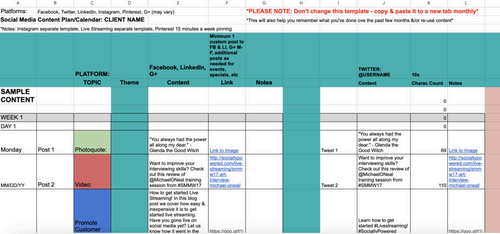
One popular option is a social media calendar template Google Sheets offers. Google Sheets is accessible, easy to use, and facilitates collaboration among team members.
You can find free templates online or create your own custom template to suit your specific needs. These templates often include columns for the post date, time, platform, content type, and notes, providing a clear overview of your content plan.
2. Trello
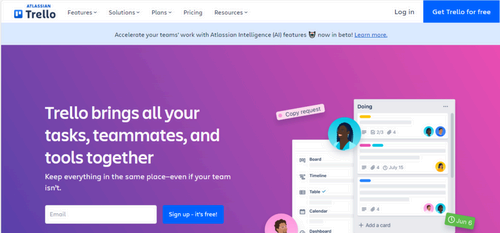
Trello is a highly visual project management tool that can be adapted into a robust social media calendar. It uses boards, lists, and cards to help you organize and prioritize your projects in a fun, flexible, and rewarding way.
With Trello, you can create cards for each piece of content, move them through stages (e.g., idea, in progress, complete), and assign tasks to team members. It’s an excellent option for those who prefer a more visual approach to content planning.
3. Asana
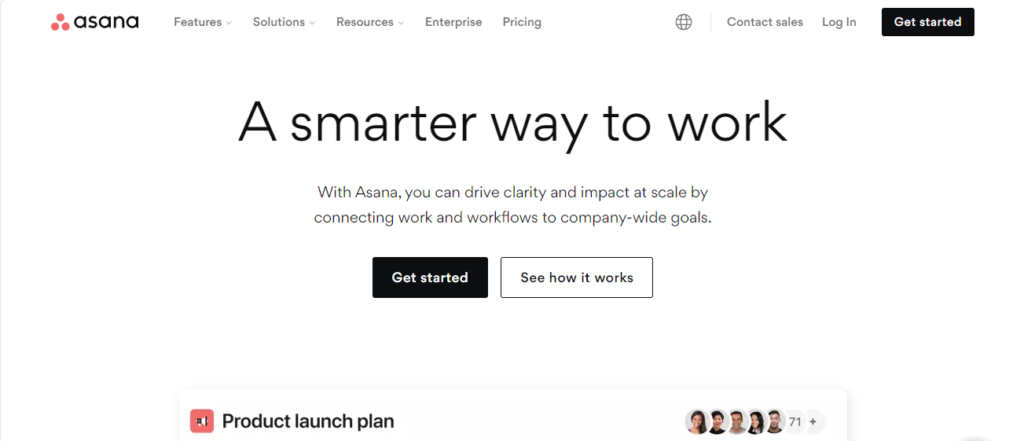
Asana is a project management tool that excels in helping teams coordinate their work. You can use Asana to create a social media calendar by setting up projects for your content plans, tasks for each post, and schedules for when each task needs to be completed.
Asana’s calendar view allows you to see your social media schedule at a glance, making it easier to ensure that your content is well-distributed across platforms and time.
These tools provide a range of options for creating a social media calendar using a template, whether you prefer the simplicity of a spreadsheet, the visual appeal of a project management board, or the functionality of a dedicated social media planning tool.
By leveraging these resources, you can ensure a more organized, efficient, and effective approach to managing your social media content strategy.
Social media calendar apps
Social media calendar apps are also essential tools for anyone looking to elevate their social media strategy. These platforms not only simplify the scheduling process but also offer a suite of features designed to enhance your social media management.
Let’s dive deeper into three popular options: Sprout Social, Hootsuite, and Buffer, exploring the unique functionalities each provides.
1. Sprout Social
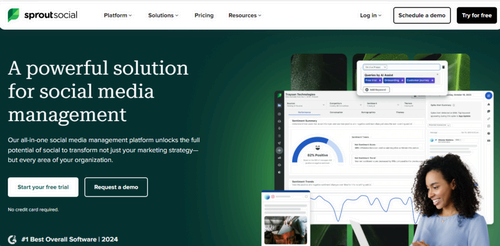
Sprout Social stands out for its comprehensive suite of social media management tools, designed to help businesses grow their social presence while engaging with their audience more effectively.
It offers an intuitive platform that supports planning, scheduling, publishing, and monitoring social media posts across multiple networks from a single dashboard.
Key Features:
- Unified Social Inbox: Allows you to manage all your social messages in one place, facilitating faster and more personal responses to your audience.
- Advanced Analytics: Provides detailed reports on your social media performance, including engagement metrics, audience growth, and the effectiveness of your content strategy.
- Content Calendar: Visualize your entire social media strategy with a centralized calendar that makes it easy to plan, schedule, and edit posts.
- Collaboration Tools: Enables teams to work together seamlessly, with features for assigning tasks, reviewing drafts, and approving content.
Ideal For: Businesses of all sizes looking for a robust platform to manage their social media efforts comprehensively, from engagement to analytics.
2. Hootsuite
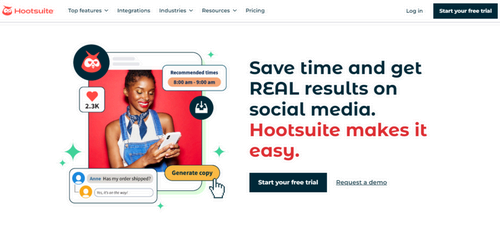
Hootsuite is one of the most well-known social media management tools, offering users the ability to schedule posts in advance, monitor social media conversations, and measure the impact of their social media campaigns. It supports a wide range of social networks, making it a versatile choice for marketers.
Key Features:
- Bulk Scheduling: Upload and schedule hundreds of social media posts at once, saving time for other tasks.
- Social Media Monitoring: Keep track of what’s being said about your brand across your social networks and respond in real-time.
- Analytics and Reporting: Measure your social ROI with comprehensive analytics that track your performance across all platforms.
- Team Management: Assign tasks, manage permissions, and approve posts within the team to streamline collaboration.
Ideal For: Businesses and marketers who need a powerful tool to manage multiple social media accounts and want to stay on top of conversations about their brand.
3. Buffer
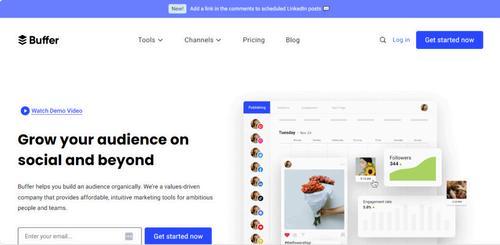
Buffer is known for its simplicity and user-friendly interface, making it a popular choice for individuals and businesses looking to streamline their social media management. It focuses on scheduling posts, analyzing performance, and engaging with followers, without the complexity of more extensive platforms.
Key Features:
- Scheduling & Publishing: Easily plan and publish content across various social media platforms with a simple, intuitive interface.
- Analytics: Track engagement metrics like clicks, likes, shares, and more to understand how your content performs.
- Pablo Image Creator: Create engaging images for your posts with Buffer’s built-in image editing tool, Pablo.
- Team Collaboration: Invite team members to collaborate, review drafts, and manage your social media accounts together.
Ideal For: Small to medium-sized businesses and individual users looking for an easy-to-use tool to manage their social media strategy effectively.
Each of these social media calendar apps offers unique features tailored to different needs and preferences. Whether you’re looking for a comprehensive management solution, a tool to monitor your brand’s social presence, or a straightforward scheduling assistant, there’s an app that fits the bill.
By leveraging these platforms, you can not only save time but also gain valuable insights into your social media calendar’s performance, enabling continuous improvement and growth.
Final thoughts
In conclusion, a well-structured social media calendar is vital for anyone looking to optimize their online presence.
By planning your content strategically, you can enhance engagement, reach your marketing goals, and maintain a strong, consistent brand image across all social media platforms.
Whether you opt for a simple template or a sophisticated app, the key is to find a system that works for you and your team, enabling you to publish timely, relevant, and compelling content that resonates with your audience.
FAQs
What is the best social media calendar?
The “best” social media calendar depends on your specific needs, team size, and the complexity of your social media strategy. Tools like Sprout Social, Hootsuite, and Buffer are popular for their comprehensive features, including scheduling, analytics, and collaboration tools. Google Sheets or Microsoft Excel can also serve as effective, customizable calendars for those with simpler needs or tighter budgets.
How do I create a social media calendar?
- Audit your current social media status to understand where you stand and where your audience is most active.
- Define your social media goals to guide the direction of your content (e.g., increase engagement, drive traffic).
- Plan your content mix, ensuring a balance of promotional, educational, and entertaining content.
- Schedule your posts based on when your audience is most active.
- Create and curate content that aligns with your goals and schedule.
- Review and adjust your calendar regularly based on performance analytics.
What does a social media calendar do?
A social media calendar helps plan, organize, and schedule your content across various platforms. It ensures consistent posting, aligns content with strategic goals, and enables tracking of what content is published and when. This organization aids in analyzing content performance and refining strategies over time.
What is a calendar of activities for social media?
A calendar of activities for social media outlines the planned posts, campaigns, and content themes for each day, week, or month. It includes details like the type of content, the platform it will be posted on, the posting date and time, and any associated hashtags or calls to action.
What does a good social media calendar look like?
A good social media calendar is clear, organized, and flexible. It includes:
- Posting dates and times for each platform.
- Content descriptions or actual content to be posted.
- Status updates (planned, scheduled, published).
- Performance metrics for tracking and analysis.
- Visual elements like images or videos to accompany posts.
- Notes for any collaborative input or strategic alignment.
What is a social media calendar template?
A social media calendar template is a pre-designed framework to help organize and plan your social media content. It usually comes in the form of a spreadsheet or software with fields for post dates, platforms, content descriptions, and other relevant details, streamlining the content planning process.
Is there a free social media scheduling tool?
Yes, there are several free social media scheduling tools available, including:
- Buffer: Offers a free plan with limited posts and accounts.
- Hootsuite: Has a free plan with basic features for individuals.
- Later: Great for visual content planning with a free starter plan.
How do I create a 30 day social media plan?
- Set clear objectives for the month (e.g., increase followers by 10%).
- Identify key themes or campaigns you want to focus on.
- Plan out your content types and frequency of posts.
- Schedule specific posts for each day, ensuring a mix that aligns with your objectives.
- Create or curate content ahead of time.
- Monitor and adjust your plan based on engagement and performance analytics.
How do I create a social media calendar in Excel?
- Open a new Excel spreadsheet.
- Create columns for Date, Platform, Post Time, Content Type, Description, Visuals, Links, Status, and Notes.
- Fill in your planned content according to your strategy, ensuring to cover all necessary details.
- Utilize Excel’s features like conditional formatting to color-code statuses or filter views for better organization.
What’s the best social media scheduler 2024?
Popular choices include Sprout Social, Hootsuite, and Buffer, thanks to their robust features catering to various needs from analytics to team collaboration. The best choice depends on your specific requirements, budget, and the size of your social media operations.
What is the best free social media scheduler?
For those looking for free options, Buffer and Later offer generous free plans that cater well to small businesses or individuals starting out. These tools provide basic scheduling capabilities and analytics to help you get started with social media management.

Free Download
The Ultimate Guide to Social Media Marketing for Business



